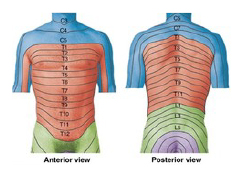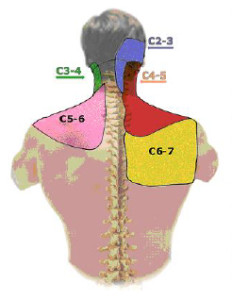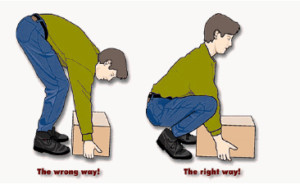Mid-Back Pain is Misunderstood
Pain in the middle of your back? Between your shoulder blades? Felt pain wrapping around your ribs? Pain in the mid-back is an area of the body that that is often misunderstood and not well treated by most medical practitioners. The cervical and lumbar spine get a lot of attention and most of the treatment. The thoracic spine, which is the part of the spine which is located in the middle of the back, is the longest part of the spine with the most discs and vertebrae. If you look at the figure below you can see how each one of the twelve thoracic nerves cover their own part of the middle of the back. They are labeled in this diagram from T1 to T12.
 Picture 1 – What I want you to notice is how each of these nerves start in the back and wrap all the way around to the front. For example, the part of the body near your shoulder blade is covered by the sixth and seventh thoracic nerves. Each nerve comes out of the spine and passes by the disc and then is attached to the bottom of the rib. What that means is if your sixth or seventh nerve is inflamed by the disc it can create pain in your shoulder blade. If you follow the T6 nerve in the above picture you can see how you may feel pain not only in the area of the shoulder blade, but also in the front of your chest, since that nerve runs all the way around to the front of the body.
Picture 1 – What I want you to notice is how each of these nerves start in the back and wrap all the way around to the front. For example, the part of the body near your shoulder blade is covered by the sixth and seventh thoracic nerves. Each nerve comes out of the spine and passes by the disc and then is attached to the bottom of the rib. What that means is if your sixth or seventh nerve is inflamed by the disc it can create pain in your shoulder blade. If you follow the T6 nerve in the above picture you can see how you may feel pain not only in the area of the shoulder blade, but also in the front of your chest, since that nerve runs all the way around to the front of the body.
Through the years I have seen many people who have had pain in the middle of the back and/or wrapping around to the front of their abdomen and have been told that they had a pulled muscle in their ribs, kidney pain, hernias, a problem with their shoulder blade or just the usual “I have no idea”. What I found in all of these patients was an irritated nerve from a disc herniation or narrowing of the hole where the nerve exists the thoracic spine.
“It feels like I can’t breathe.”
A lot of patients will tell me that they feel pain just in the middle of their back, and others will tell me that they will feel that the pain starts on one side of their mid-back and wraps around their ribs. I have had patients tell me that they really thought they had a broken rib. Others have come to see me because of pain they thought was coming their kidneys or the front of their stomach area but their medical physicians could not find anything wrong with them. Again, what was going on with each one of these patients was that one of the thoracic nerves was inflamed in the spine and was creating these different pains.
One area of the mid-back that seems to be really confusing is when patients have pain in the shoulder blade area. What should be noted is that this area of pain can either be due to the cervical or thoracic spine. Look at the picture below of the areas of pain created by the cervical spine.
 Picture 2 – If you look at the area of the shoulder blade you can see that the C6-7 cervical disc or nerve in your neck can create pain in this area. If you look at picture 1 what you see is that the T6-7 thoracic disc or nerve can also create pain in the same area. There is a very simple trick that can sometimes help you tell the difference between the two if you are hurting in that area. Get someone to run a paper clip down that area of the spine that you are hurting. If you notice that you are hypersensitive to the touch of the paper clip in the area that you are hurting, then your pain is coming from the thoracic spine. If you are not hypersensitive, then your shoulder blade pain is usually coming from your neck. This is not full proof but I am amazed the number of times it has helped me with a diagnosis.
Picture 2 – If you look at the area of the shoulder blade you can see that the C6-7 cervical disc or nerve in your neck can create pain in this area. If you look at picture 1 what you see is that the T6-7 thoracic disc or nerve can also create pain in the same area. There is a very simple trick that can sometimes help you tell the difference between the two if you are hurting in that area. Get someone to run a paper clip down that area of the spine that you are hurting. If you notice that you are hypersensitive to the touch of the paper clip in the area that you are hurting, then your pain is coming from the thoracic spine. If you are not hypersensitive, then your shoulder blade pain is usually coming from your neck. This is not full proof but I am amazed the number of times it has helped me with a diagnosis.
Pain in the area of the shoulder blade, ribs and upper back that is due to the inflammation of the thoracic disc or nerve usually gets worse with specific movements that are going to place pressure of the disc, which in turn can aggravate the pain from the nerve. Bending forward and twisting type motions are two common reasons that make an inflamed thoracic disc and nerve worse. Sitting for extended periods of time can also put a lot of pressure on the thoracic discs, especially if you sit in a slumped position.
I try to get patients with this type of pain to sit as straight as possible and attempt to limit activities such as golf, tennis, and yoga until we can get the inflammation out of the disc and nerve. I also stress the importance in using your legs to do most of the bending, as that will put less pressure on the disc and the nerves as the thoracic spine will remain straight as you bend down to pick things up.
 Picture 3 – An MRI of the mid-back or thoracic area may not show an obvious herniation or narrowing of the hole where the thoracic nerve exists and wraps around your body. Thru the years I have seen countless patients that have NOT been treated due to the fact that there are little findings on the MRI, and their pain has gone away after I treated them. The MRI is done with the patient laying down, and therefore the changes you see when the weight of the body is on the disc is missed. The MRI is not the diagnostic tool that everyone thinks it it and should not be used by itself to make clinical decisions!!
Picture 3 – An MRI of the mid-back or thoracic area may not show an obvious herniation or narrowing of the hole where the thoracic nerve exists and wraps around your body. Thru the years I have seen countless patients that have NOT been treated due to the fact that there are little findings on the MRI, and their pain has gone away after I treated them. The MRI is done with the patient laying down, and therefore the changes you see when the weight of the body is on the disc is missed. The MRI is not the diagnostic tool that everyone thinks it it and should not be used by itself to make clinical decisions!!
This area of the spine is an easy area for us to treat with the use of the fluoroscopy (continuous x-ray) as we are able to locate the specific thoracic nerve with this technique. We also tend to obtain long-term relief with our procedures due to the fact that there is a lot less movement of the thoracic spine compared to the cervical or lumbar due to the ribs being attached to the thoracic spine.
